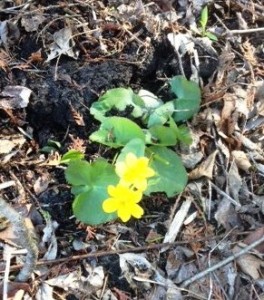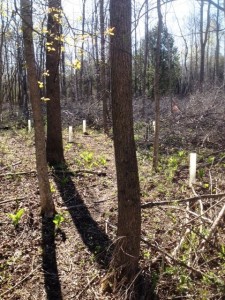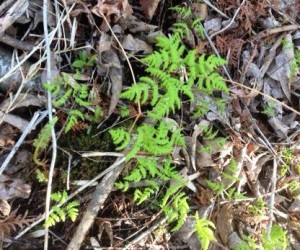For those of us who plant, be it shrubs and wildflowers or petunias in the backyard, spring is the time when our rewards are reaped. Restoration ecologists hold their breath over the winter, wondering if last year’s plantings will survive the cold and browsing that accompanies that season. Spring is a time of reckoning when the results of last year’s decisions are revealed. What survived, and what didn’t, are often equally surprising. Some plants which were hastily thrust into the ground during the last busy spring are thriving, while others which were carefully planted and tended have given up their ghosts. But if the number which survive outdoes the number that succumb, there is cause for happiness.
Last year our staff and volunteers (hundreds of them) worked on several Restore the Shore projects, trying to restore or improve habitat for wildlife in different locations in and near our preserve. Hundreds of hours were spent removing invasive buckthorn, honeysuckle, and barberry and treating the cut stems so they don’t grow back and smother the native plants. In their place, native trees and shrubs were planted and tubes or fencing was installed to keep deer and rodents away. Many were also mulched and watered as needed, but last summer the rain was regular and most of the time adequate to keep the plantings moist. At the end of summer, almost all of the plants were alive and well.
This spring we have been continuing the restorations, and at the same time evaluating last year’s work. In most of the areas, the plantings have survived very well. All of the larger trees have survived along with the majority of the shrubs and tree seedlings, encompassing at least 30 different species. An exception was white pines- we didn’t protect them and were surprised how much the deer enjoyed them last winter.
There are several restoration sites within Woodland Dunes- along the Ice Age Trail near Aurora Medical Center, along Goodwin Road, and also several places along Columbus Street. Along the Lakeshore, there is a restoration site at the Rotary Garden wayside on Memorial Drive, where 300 shrubs were planted to provide food for migrating songbirds.
Perhaps the most difficult and yet remarkable site was at Zander Park across the street from our preserve. People know Zander for it’s dog exercise area and playground, but most of the park is a wetland forest. That forest was incredibly invaded with honeysuckle and many large buckthorn trees. Both of those invasive species produce lots of berries which have either little nutrition or are actually harmful to songbirds. Managing that forest is an important part of managing our own preserve because birds carry the seeds which impact our habitat as well. The City of Two Rivers is supporting the project was willing to help us obtain grant funding to work on both areas, and to date an incredible amount of invasive plant material has been cut. As that continues, we are planting a variety of native species and protecting the remaining native plants we find struggling to grow in the forest. As we remove the invasive blanket, wonderful wildflowers are being found underneath- nodding trilliums, meadowrue, jack-in-the-pulpit, skunk cabbage, wood violets and others such as sensitive and oak ferns. These woodland plants would have very likely been lost due to competition for space, shade, and chemical alterations of soil that invasive plants produce.
As a finishing touch, Eagle Scout candidate Cullen Hilliker from Two Rivers built a small sitting area for nature lovers, with two benches surrounded by native shrubs, a flowering crabapple tree, and some wildflowers right along Columbus Street. Here people can relax, enjoy, and appreciate what was formerly a tangle of nasty plants that don’t belong here. During a recent visit there, a Swainson’s thrush picked around the newly planted shrubs, and an ovenbird, magnolia warbler, cardinals, and an oriole sang from the trees around. These restoration projects are a very real way to make the world a better place, give wildlife species the home they deserve, and give us a place to rest and appreciate. Once begun they never end, like any gardening project, so if you’d like to help just contact us.



